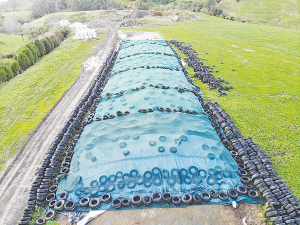Technology and nutrition – a combined approach
Farm technology is an exciting frontier, and it's changing how we manage herds.
 CoverTex, a heavy-duty knitted shade cloth, is fabricated in the Cosio Industries warehouse in Auckland.
CoverTex, a heavy-duty knitted shade cloth, is fabricated in the Cosio Industries warehouse in Auckland.
Until recently Ingelwood farmer Nigel King’s 75-metre maize stack looked like an aviary and he was losing quality feed.
Led by pukekos, birds were feasting on the maize silage, stored on farm as supplementary feed for his 540 cows.
King says that with their long beaks, pukekos pecked large holes on the plastic cover to access maize silage: this allowed water to seep in and damage the feed.
“For the past two to three years I was losing silage, it’s hard to quantify how much,” he told Dairy News.
“The silage was mouldy because water seeped in through the holes and the cows didn’t like it.
“There was also wastage because the birds took out silage from the holes and left them all over the place.”
King looked at his options; poison was ruled out because it would have killed not only pukekos but the other birds.
“And, I don’t like doing that,” he says.
“It was like an aviary out there; the pukekos pecked these large holes and other birds joined the feasting.”
But things changed overnight. About four months ago, he bought CoverTex shade cloth, which goes on top of the plastic cover on the silage stack. King says he keeps some tyres in between the two layers for separation and this makes it almost impossible for a persistent pukeko to reach the plastic beneath.
While placing tyres on the silage plastic first is not essential, it has the effect of suspending the CoverTex above the plastic making. While still easier than covering the entire plastic stack with tyres, this method uses slightly more tyres than placing the CoverTex directly over the plastic.
The birds have disappeared.
“We have not seen a single bird on the stack since the day CoverTex went up,” he says.
“The pukekos haven’t come back. Either they found that that their ability to peck holes has been eliminated or they don’t like the texture and walking on the material.”
CoverTex, a heavyduty knitted shade cloth, is fabricated in the Cosio Industries warehouse in Auckland: manufactured in segments makes it easier to handle.
Gravel bags - from Cosio Industries- are then used to ballast the CoverTex at the overlaps between segments and around the perimeter. The CoverTex cover holds down the silage cover. While this method eliminates the use of tyres altogether, tyres already on the farm could be used for the ballast in place of the gravel sausages. The gravel bags are filled on site with pebbles or pea metal and cable tied closed. They have user-friendly handles which make them easy to shift. When filled they can hold up to 13kg of ballast, they do not hold water which makes them easy to manage and compact to store.
Cosio says packing them away is like stacking potato bags on a pallet to store when not in use.
Federated Farmers says it is cautiously welcoming signals from the Government that a major shake-up of local government is on its way.
Ashburton cropping and dairy farmer Matthew Paton has been elected to the board of rural services company, Ruralco.
The global agricultural landscape has entered a new phase where geopolitics – not only traditional market forces – will dictate agricultural trade flows, prices, and production decisions.
National Lamb Day is set to return in 2026 with organisers saying the celebrations will be bigger than ever.
Fonterra has dropped its forecast milk price mid-point by 50c as a surge in global milk production is putting downward pressure on commodity prices.
The chance of a $10-plus milk price for this season appears to be depleting.